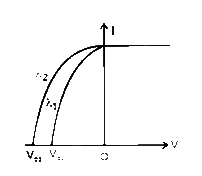If V1andV2 are stopping potentials for incident photons of wavelengths λ1andλ2 for same cathode material, then Planck's constant is given by [e = charge on electron, c = speed of light]Solution in Marathi
ec(V2−V1)λ1λ2λ1−λ2
ec(λ1−λ2)V1V2V1−V2
ecV2V1λ1λ2
ec(λ1+λ2)(V1+V2)
The correct Answer is:A
Step by step video & image solution for If V_1 and V_2 are stopping potentials for incident photons of wavelengths lambda_1 andlambda_2 for same cathode material, then Planck's constant is given by [e = charge on electron, c = speed of light] by Physics experts to help you in doubts & scoring excellent marks in Class 11 exams.
Updated on:21/07/2023Topper's Solved these Questions
- ELECTRONS AND PHOTONSBOOK - TARGET PUBLICATIONCHAPTER - ELECTRONS AND PHOTONSEXERCISE - Competitive Thinking
80 Videos
- ELECTRONS AND PHOTONSBOOK - TARGET PUBLICATIONCHAPTER - ELECTRONS AND PHOTONSEXERCISE - Evaluation Test
19 Videos
- ELECTRONS AND PHOTONSBOOK - TARGET PUBLICATIONCHAPTER - ELECTRONS AND PHOTONSEXERCISE - Evaluation Test
19 Videos
- COMMUNICATION SYSTEMSBOOK - TARGET PUBLICATIONCHAPTER - COMMUNICATION SYSTEMSEXERCISE - Evaluation Test
15 Videos
- ELECTROSTATICSBOOK - TARGET PUBLICATIONCHAPTER - ELECTROSTATICSEXERCISE - EXCERCISE
156 Videos
Similar Questions
The electrons are emitted in the photoelectricm effect from a metal surface
View SolutionRelation between the stopping potential V0 of a metal and the maximum velocity of the photoelectrons is
View SolutionRelation between the stopping potential V0 of a metal and the maximum velocity of the photoelectrons is
View SolutionThe critcal frequency for sky wave propagation if maximum number density of electrons in ionosphere is 1010m−3 is
View SolutionElectrostatic means study of
View SolutionIn a photoelectric experiment, the graph of frequency v of incident light (in Hz) and stopping potential V (in V) is as shown in the figure. Planck's constant is (e is the elementary charge)
View SolutionIf m is the mass of an electron and c the speed of light, the ratio of the wavelength of a photon of energy E to that of the electron of the same energy is
View SolutionIf m is the mass of an electron and c is the speed of light then the ratio of wavelength of a photon of energy E to that of the electron of the same energy is
View SolutionIf V_1 and V_2 are stopping potentials for incident photons of wavelengths lambda_1 andlambda_2 for same cathode material, then Planck's constant is given by [e = charge on electron, c = speed of light]
View SolutionWhen light of frequency v1 incident on a metal with work function W0 (where hv1>W0), the photocurrent falls to zero at a stopping potential of V1. If the frequency of light is increased to v2, the stopping potential changes to V2. Therefore, the charge of an electron is given by
View SolutionIn the given diagram if V represent the stopping potential and wavelength of incident light is λ. If V2>V1 then

View SolutionThreshold wavelength for metal is 10,000Å . If light of wavelength 5461Å is incident on it, then stopping potential is 1.02 V, then value of Planck's constant is :
View SolutionThreshold wavelength for metal is 10,000 Å. If light of wavelength 5461 Å is incident on it, then stopping potential is 1.02 V, then value of Planck's constant is :
View SolutionIf 'm' is the mass of an electron and 'c' is the speed of light, the ratio of the wavelength of a photon of energy E to that of the electron of the same energy is
View Solutionआइन्स्टीन का प्रकाश वैद्युत समीकरण लिखिए। किसी धातु पृष्ठ के लिए जब आपतित प्रकाश की तरंगदैर्घ्य λ1 है तब निरोधी विभवन V1 तथा तरंगदैर्घ्य λ2 पर निरोधी विभव V2 है। प्लांक नियतांक के लिए सूत्र प्राप्त कीजिए।
View Solution
